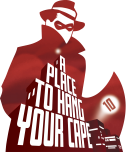Sliced Quarterly is back and, with extraordinary topicality, editor Ken Reynolds has termed it his “Marmite issue”. For not only is it unavailable in Tesco’s, it’s by far the boldest, tangiest, most umami-rich and polarising issue yet. As Reynolds puts it, there’s “work that some would dispute being comics at all, that some will actively not enjoy reading”. It seems that with the upcoming compendium ready to hit the presses, Sliced #4 is going all out to offer the lover of indie press and alternative comics something to really sink their teeth into.
Ken, you had me at “truly challenging content”.
So, without tearing the bread, let’s extract the yeast of Sliced Quarterly #4.
More than previous issues, Sliced #4 offers a challenge to traditional linear narratives. “My Cosmic Autumn” by Andrew Pawley is all about capturing a mood, rather than telling a yarn. And what’s not to like? Colourful phoenixes rise from the skulls of two undead call centre workers, as they stand slack-jawed and blear-eyed on the tube. It’s basically my biography in comic form.
Kathryn Briggs‘ “08226” takes a similarly expressionistic approach to storytelling. The strip tells the story of “Grammy Briggs” and her New Jersey summer house through a collage of watercolour still-life and text, superimposed upon assorted maps. The result is a highly effective palimpsest of successive years of memory and experience that brings the author’s past vividly to life. I adored the line, “cantaloupes with lurid perfume offended me, but whose remains decorated my sister’s face like gore”. You rarely get lines like that in The Beano.
“Implosion Flower” dispenses with narrative altogether. Artist Gareth A. Hopkins‘ abstract, eroticised line drawings flow from panel to panel like a Georgia O’Keefe flower painting on acid, while Erik Blagsvedt‘s cut and paste words read like a Dadaist poem or William S. Burroughs story. There seems to be no correct way to read the story. Right to left like a European novel, left to right like a manga comic, even “as the ox-plow turns” like the early Athenians, however you approach “Implosion flower”, one feels the same orgasmic rhythm pulsing through the words and images. Best read with a tissue handy.
The real widowmaker of the anti-narrative pieces is, for me, Charles Ripley (script) and Ken Reynolds‘ (design) “Cliffs Of Dover”. The strip consists of a randomly placed series of boxes on a computer screen, with equally random script notes and what appears to be a marriage proposal gone wrong. In fairness, Reynolds does state in the preface that this issue was to be his Ulysses and “Cliffs Of Dover” would appear to be very much in the baffling spirit of James Joyce‘s impenetrable doorstop. As someone who has repeatedly failed to get past chapter two of Ulysses (something about a fried breakfast?), I’m man enough to admit when I just don’t get it, and I just didn’t get this. Was it an exercise in self-indulgence or am I simply as thick as Robin Thicke at a copyright infringement hearing? Ripley’s line about “constantly growing negative space” seemed to capture the mood though. Could that be the point?
Truth is, that’s the real joy of Sliced Quarterly. You won’t necessarily like everything but at least you’ll see something new. Maybe the doors of your perception will be expanded or maybe, like me, you’ll be too lazy to look up the quotes and just move on to the next strip.
And Issue #4 has some great, darkly humorous strips to sit alongside the more esoteric ones. These lighten the mood and mess with the viewer’s head in delightful ways.
Cat Byrne‘s “Mediorc” in particular tickled me greatly with its Tolkein-on-an-off-day tale of goblin banality. I’d love to see a series of these. They’d make for a fantastic serial strip in a sci-fi/fantasy magazine.
Portuguese writer Sergio Santos and artist Tania A. Cardoso team up on “Punishment”, a morality tale on the evils of admin, told in gorgeous black and white with baroque flourishes of crimson (Think Dickens‘ A Christmas Carol on steroids). It is a timely reminder that the youthful art of comics transcends national borders and insular drawbridge draw-upping that our elders are currently obsessed with.
In “Limits” by S.J. McCune we are presented with a piece inspired by a gallery visit. Frozen portraits look on in envy at a living viewer (the sort of retro-haired, pouty hipster I look on at in envy whenever forced to visit an art gallery – “But, oh that I was young again”), only for that living viewer to herself realise that she is a frozen portrait in a comic strip. That’s some serious metaphizzle shizzle.
Finally, Tara Lucy‘s “Self-Checked Out” is a wonderful dystopian tale set in the far future of 2016 – A world where the quotidian act of grocery shopping has been hijacked by automated tills, turning the simplest of purchases into a Kafka-esque nightmare of miss-weighed fruit and unexpected items in bagging areas. Let’s pray it never comes to pass.
In summary, Sliced Quarterly #4 does indeed challenge the viewer, more so than any previous issue. If you think that’s a bad thing then Sliced is probably not the publication for you. It is, by turns, uncomfortable, esoteric and downright frustrating. It is also witty, charming, unfailingly imaginative, and often luminously brilliant.
If you like words and pictures – If you like talking, arguing and generally musing about words and pictures (preferably while wearing a beret and smoking a Gauloise), then you simply must check out this issue.
Let’s enjoy this Marmite while it’s still on the shelf!
Have you read Sliced Quarterly‘s 4th issue? What did you make of it? Sound off in the comments section below or send us a Tweet! You can download all four issues of Sliced Quarterly for free here, and back the Kickstarter campaign for the collected edition of Sliced Quarterly here!

